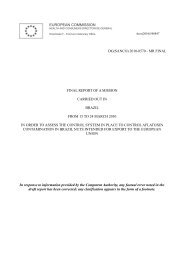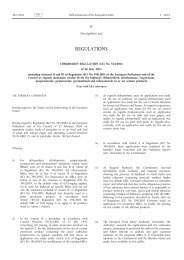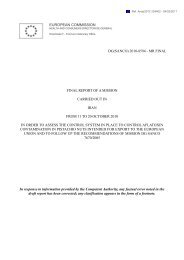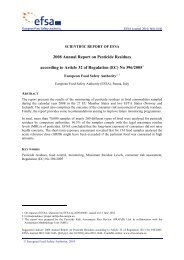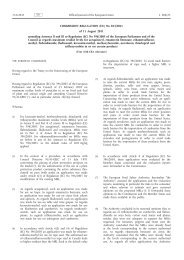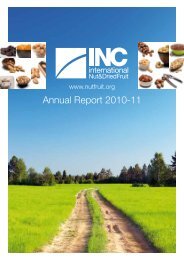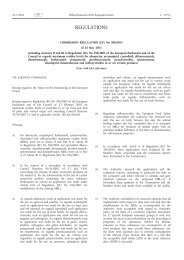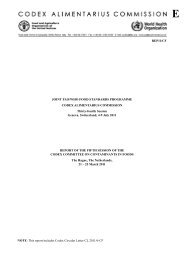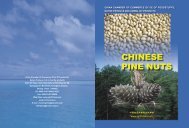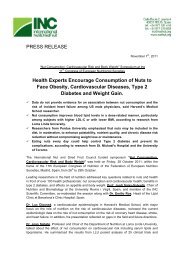Download - International Nut and Dried Fruit Council
Download - International Nut and Dried Fruit Council
Download - International Nut and Dried Fruit Council
Create successful ePaper yourself
Turn your PDF publications into a flip-book with our unique Google optimized e-Paper software.
[Federal Register: December 8, 2010 (Volume 75, Number 235)][Rules <strong>and</strong> Regulations][Page 76284-76292]From the Federal Register Online via GPO Access [wais.access.gpo.gov][DOCID:fr08de10-14]=======================================================================-----------------------------------------------------------------------ENVIRONMENTAL PROTECTION AGENCY40 CFR Part 180[EPA-HQ-OPP-2006-0766; FRL-8853-8]RIN 2070-AJ28Pesticide Tolerance Crop Grouping Program II; Revisions toGeneral Tolerance RegulationsAGENCY: Environmental Protection Agency (EPA).ACTION: Final rule.-----------------------------------------------------------------------SUMMARY: This final rule makes revisions to the current pesticidetolerance crop grouping regulations which allow establishment oftolerances for multiple related crops, based on data from arepresentative set of crops. The final rule creates a new crop groupfor oilseeds, exp<strong>and</strong>s existing crop groups by adding new commodities,establishes new crop subgroups, <strong>and</strong> revises the representative crops insome groups. EPA expects these revisions to promote greater use of cropgroupings for tolerance-setting purposes <strong>and</strong> promote globalharmonization of food safety st<strong>and</strong>ards. EPA anticipates that morelower-risk pesticides will be able to be utilized for registration onminor crops, including many fruits <strong>and</strong> vegetables, because ofavailability of crop grouping tolerances. EPA determines whether[[Page 76285]]residues of a pesticide can be permitted once the required safetyfinding is made to establish a crop group tolerance. This is the secondin a series of planned crop group updates expected to be promulgatedover the next several years.DATES: This final rule is effective February 7, 2011.ADDRESSES: EPA has established a docket for this action under docketidentification (ID) number EPA-HQ-OPP-2006-0766. All documents in thedocket are listed in the docket index available at http://frwebgate.access.gpo.gov/cgibin/leaving.cgi?from=leavingFR.html&log=linklog&to=http://www.regulations.gov.Although listedin the index, some information isnot publicly available, e.g., Confidential Business Information (CBI)or other information whose disclosure is restricted by statute. Certainother material, such as copyrighted material, is not placed on theInternet <strong>and</strong> will be publicly available only in hard copy form.Publicly available docket materials are available in the electronicdocket at http://frwebgate.access.gpo.gov/cgi-bin/leaving.cgi?from=leavingFR.html&log=linklog&to=http://www.regulations.gov, or, if only available in hardcopy, at the OPP Regulatory Public Docket in Rm. S-4400, One PotomacYard (South Bldg.), 2777 S. Crystal Dr., Arlington, VA. The DocketFacility is open from 8:30 a.m. to 4 p.m., Monday through Friday,excluding legal holidays. The Docket Facility telephone number is (703)305-5805.FOR FURTHER INFORMATION CONTACT: Rame Cromwell, Field <strong>and</strong> ExternalAffairs Division, Office of Pesticide Programs, EnvironmentalProtection Agency, 1200 Pennsylvania Ave., NW., Washington, DC 20460-0001; telephone number: (703) 308-9068 ; fax number: (703) 305-5884; e-mail address: cromwell.rame@epa.gov.SUPPLEMENTARY INFORMATION:I. Does this action apply to me?You may be potentially affected by this action if you are anagricultural producer or food manufacturer. Potentially affectedentities may include, but are not limited to:Crop production (NAICS code 111), e.g., agriculturalworkers; greenhouse, nursery, <strong>and</strong> floriculture workers; farmers.Animal production (NAICS code 112).Pesticide manufacturing (NAICS code 32532).This listing is not intended to be exhaustive, but rather providesa guide for readers regarding entities likely to be affected by this
action. Other types of entities not listed in this unit could also beaffected. The North American Industrial Classification System (NAICS)codes have been provided to assist you <strong>and</strong> others in determiningwhether this action might apply to certain entities. If you have anyquestions regarding the applicability of this action to a particularentity, consult the person listed under FOR FURTHER INFORMATIONCONTACT.II. BackgroundA. What action is the agency taking?This final rule, under the provisions of section 408 of the FederalFood, Drug, <strong>and</strong> Cosmetic Act (FFDCA), amends EPA's regulationsgoverning crop group tolerances for pesticides. Specifically, the rule:(1) Creates a new crop group for oilseeds; (2) exp<strong>and</strong>s existing cropgroups by adding new commodities; (3) establishes new crop subgroupsfor two groups; (4) changes the representative crops for two groups;<strong>and</strong> (5) deletes 40 CFR 180.1(h), which addresses when tolerances applyto post-harvest uses.The crop grouping concept leads to an estimate of the maximumresidue that could occur on any crop within the group. The minimum datarequired for a group tolerance consists of residue data for allrepresentative commodities for a group. This action is intended topromote more extensive use of crop group tolerances <strong>and</strong>, in particular,will assist in making available lower-risk pesticides for minor cropsboth domestically <strong>and</strong> in countries that export food to the UnitedStates.This final rule is the second in a series of planned crop groupupdates expected to be promulgated in the next several years.B. What is the agency's authority for taking this action?EPA is authorized to establish tolerances for pesticide chemicalresidues in food under FFDCA section 408. EPA establishes tolerancesfor each pesticide based on the potential risks to human health posedby that pesticide. A tolerance is the maximum permissible residue levelestablished for a pesticide in raw agricultural produce <strong>and</strong> processedfoods. The crop group regulations currently in 40 CFR 180.40 <strong>and</strong> 180.41enable the establishment of tolerances for a group of crops based onresidue data for certain crops that are representative of the group.Crop group regulations are promulgated under section 408(e)(1)(C) whichauthorizes EPA to establish ``general procedures <strong>and</strong> requirements toimplement [section 408].'' 21 U.S.C. 346a(e)(1)(C).III. The Proposed RuleEPA published a notice of proposed rulemaking in the FederalRegister of January 6, 2010 (75 FR 807). Written comments weresolicited <strong>and</strong> were received from five parties in response to theproposal. Comments were received from Bayer CropScience, a commercialapplicator, The National Sunflower Association, The California CitrusQuality <strong>Council</strong> <strong>and</strong> the General Administration of Quality Supervision,Inspection <strong>and</strong> Quarantine of the People's Republic of China.IV. Response to CommentsIn this section EPA describes the major provisions of the proposedrule, the comments received on each provision, <strong>and</strong> EPA's responses tothose comments, including EPA's determination if any modification ofthe proposed rule is warranted.A. Crop Group 8-10: <strong>Fruit</strong>ing Vegetable GroupThe final rule retains the pre-existing Crop Group 8 <strong>and</strong> adds a newgroup titled ``Crop Group 8-10 <strong>Fruit</strong>ing Vegetable Group.''1. Add commodities. Newly added Crop Group 8-10, exp<strong>and</strong>s thefruiting vegetable crop group from the existing 6 commodities in CropGroup 8 to 21 commodities.2. Change the name. The final rule changes the name of ``Crop Group8 <strong>Fruit</strong>ing Vegetables (Except Cucurbits)'' by dropping theparenthetical ``(Except Cucurbits)'' from the name.3. Change the name of representative commodities. The final rulechanges the name of the representative commodities for the revised cropgroup from ``one cultivar of non-bell pepper'' to ``one cultivar ofsmall nonbell pepper'' by designating a small variety of nonbell pepper<strong>and</strong> by deleting the hyphen from the term non-bell.4. Create new subgroups. The final rule retains the proposedaddition of three subgroups to crop group 8-10.i. Tomato subgroup 8-10A--Representative crop. Tomato, st<strong>and</strong>ardsize <strong>and</strong> one cultivar of small tomato. Eleven commodities are includedin this subgroup.ii. Pepper/Eggplant subgroup 8-10B--Representative crop. Bellpepper <strong>and</strong> one cultivar of small nonbell pepper. Ten commodities areincluded in this subgroup.iii. Nonbell Pepper/Eggplant subgroup 8-10C--Representative crop.
One cultivar of small nonbell pepper or one cultivar of small eggplant.Nine commodities are included in this subgroup.One comment was received regarding whether residue data are beingcollected on only bell pepper. The commenter asked whether tolerancesshould be[[Page 76286]]established for the crop subgroup 8-10B except nonbell pepper.EPA believes that in order to obtain a tolerance for the Pepper/Eggplant subgroup 8-10B, residue data are required for both of therepresentative commodities, bell pepper <strong>and</strong> one cultivar of smallnonbell pepper. Of these two commodities, small nonbell pepper is thecommodity that will typically result in the higher residues <strong>and</strong>therefore, best represents expected residues for all of the commoditiesin subgroup 8-10B. However, bell pepper is included as a representativecommodity since it is more widely grown <strong>and</strong> consumed. Therefore, ifresidue data for only bell pepper are submitted, EPA will not recommenda tolerance for crop subgroup 8-10B except nonbell pepper, but willonly recommend for a tolerance on pepper, bell.The People's Republic of China asked EPA to clarify whether the``goji berry'' that is being included in Crop Group 8-10 is intended tocover fresh goji berry, dried goji berry, or both. China expressed theview that the pesticide tolerance level should be different betweenfresh <strong>and</strong> dried berry due to the different moisture contents. Chinarequested that EPA specify the coefficient of conversion between dried<strong>and</strong> fresh goji berry if both are put into Crop Group 8-10. According toChina, the coefficient between fresh <strong>and</strong> dried berry is approximately6:1 based on producing <strong>and</strong> processing practice.The United States generally establishes tolerances for rawagricultural commodities, which also apply to all processed forms ofthe same commodity. A separate tolerance for the processed commodity isonly necessary when residues in the processed commodity may be higherthan the raw agricultural commodity tolerance. In most cases, separatetolerances for processed commodities are not needed. Adding goji berryto Crop Group 8-10 means that future tolerances established for thisgroup will apply to goji berry in all its forms, including dehydrated(dry) goji berry. EPA is not including in the rule the coefficient ofconversion between dried <strong>and</strong> fresh goji berries. The information is notincluded in any U.S. tolerances <strong>and</strong> such information is unnecessary forthe enforcement of tolerances.EPA adopts this proposal as final without change.B. Crop Group 10-10: Citrus <strong>Fruit</strong> GroupThe final rule adds a new citrus crop group, but retains preexistingCrop Group 10 <strong>and</strong> titles it ``Crop Group 10-10 Citrus <strong>Fruit</strong>Group.''1. Add commodities. Added Crop Group 10-10 exp<strong>and</strong>s from theexisting 12 commodities in Crop Group 10 to 28 commodities.2. Change the crop group name. The final rule changes the name of``Crop Group 10: Citrus <strong>Fruit</strong>s Group (Citrus spp., Fortunella spp.)''to ``Crop Group 10: Citrus <strong>Fruit</strong> Group.3. Create crop subgroups. The final rule retains the proposedaddition of three new subgroups to newly added Crop Group 10-10.i. Orange Subgroup 10-10A. Representative commodities. Orange orTangerine/M<strong>and</strong>arin. Twelve commodities are included in this subgroup.ii. Lemon/Lime Subgroup 10-10B. Representative commodities. Lemonor Lime. Twelve commodities are included in this subgroup.iii. Grapefruit Subgroup 10-10C. Representative commodities.Grapefruit. Five commodities are included in this subgroup.EPA received no comments on this section <strong>and</strong> adopts the proposedchanges as final without change.C. Crop Group 11-10: Pome <strong>Fruit</strong> GroupThe final rule adds a new pome fruit crop group which is titled``Crop Group 11-10 Pome <strong>Fruit</strong> Group.'' Newly added crop group 11-10exp<strong>and</strong>s the pome fruit crop group, but retains pre-existing Crop Group11.Add commodities. Newly added Crop Group 11-10 exp<strong>and</strong>s from theexisting 7 commodities in Crop Group 11 to 12 commodities.EPA received no comments on this section <strong>and</strong> adopts its proposedchanges as final without change.D. New Crop Group 20 Oilseed GroupEPA received no comments on the addition of a new group, Crop Group20 Oilseed Group, <strong>and</strong> adopts its proposed addition without change.E. Amendment to Definitions <strong>and</strong> InterpretationsEPA proposed to revise the commodity definition in 40 CFR 180.1(g)for Citrus Group as follows:Tangerine = Tangerine (m<strong>and</strong>arin or m<strong>and</strong>arin orange), Clementine,Mediterranean m<strong>and</strong>arin, Satsuma m<strong>and</strong>arin, Tangelo, Tangor, cultivars,
varieties <strong>and</strong>/or hybrids of these.No comments were submitted on this section <strong>and</strong> EPA adopts thechange as proposed without change.F. Amendment to 40 CFR 180.1(h)The final rule deletes 40 CFR 180.1(h) that reads: ``Unlessotherwise specified, tolerances <strong>and</strong> exemptions established under theregulations in this part apply to residues from only preharvestapplication of the chemical.''One comment was received concerning how a person would know if atolerance is based on pre-harvest or post-harvest use. The commenterasserted that growers need to know what residues they should expectfrom pre-harvest use in order to compare maximum residue limits (MRLs,the international term for residue st<strong>and</strong>ards comparable to toleranceregulations under U.S. law) abroad to know if such commodities may beexported.Given the enforcement concerns articulated in the proposed rule,EPA does not think that the commenter has provided a sufficientrational for maintaining 40 CFR 180.1(h). EPA does not believe that theissue raised by the commenter--the need to determine whether preharvestresidues comport with international MRLs--will often be aproblem. The overwhelming majority of pesticide tolerances are setbased on pre-harvest use of a pesticide. Further, EPA attempts toharmonize tolerances with foreign MRLs, <strong>and</strong> generally, harmonization isnot a problem. Thus, in most cases, comparing the U.S. tolerance levelwith the international MRL will indicate to a grower that pre-harvesttreatment of a commodity will not be inconsistent with internationalMRLs. If a grower comes across an instance where a U.S. tolerance ishigher than a MRL <strong>and</strong> the grower thinks that a higher U.S. tolerance isdue to a post-harvest use, the grower may contact EPA for moreinformation about that particular tolerance. EPA currently collectsvaluable information about tolerances on its Web site. (http://frwebgate.access.gpo.gov/cgi-bin/leaving.cgi?from=leavingFR.html&log=linklog&to=http://www.epa.gov/opp00001/regulating/part-180.html%23info). If information onwhat tolerances are driven by post-harvest uses turns out to becritical information EPA will consider adding that information to itsWeb site.EPA is adopting its proposal without change.G. Other CommentsOne comment was received concerning the new crop group <strong>and</strong> cropsubgroups; the commenter asked whether the residue chemistry guidelineswill be updated or an EPA memor<strong>and</strong>um issued to address the number oftrials <strong>and</strong> locations needed?EPA does not believe that the residue chemistry guidelines need tobe updated at this time or a separate memor<strong>and</strong>um issued to address thenumber of trials <strong>and</strong> locations. EPA plans to update these guidelineswhen more of the crop groups are revised, as this is an ongoing[[Page 76287]]effort. For the present, the current residue chemistry guidelines whichaddress the number of field trials <strong>and</strong> locations should still be usedfor the newly added crop groups <strong>and</strong> crop subgroups.The People's Republic of China suggested that this crop group ruleshould be regarded as a measure under the Agreement on Application ofSanitary <strong>and</strong> Phytosanitary Measures (SPS Agreement) because this cropgrouping regulation has a direct relation on the establishment ofpesticide tolerances. According to the WTO/SPS agreement, the U.S.should submit a notification to WTO. The commenter hoped that the U.S.will fulfill its transparency obligation <strong>and</strong> provide other membersnotice of the measure <strong>and</strong> an opportunity to comment on it.EPA notes that the WTO was notified of the proposed rule as ofMarch 17, 2010, under the SPS Agreement. The notification, WTO DocumentG/SPS/N/USA/1980, included a link to the public docket, where theproposed rule can be found in its entirety.The People's Republic of China inquired as to the next steps afterthis revision, since the proposed revision did not specify thepesticide tolerances for the products. The commenter hoped that theU.S. would provide a timetable for the establishment of MRLs for theproducts in the revision, especially goji berry. Additionally thecommenter asked if EPA would notify the WTO in a timely fashion <strong>and</strong>provide other members with a 60-day comment period when EPA establishesMRLs. Finally, the People's Republic of China indicated that it willcontinue to follow this issue closely <strong>and</strong> hopes to comment on anyfuture tolerances for goji berry.No specific tolerances are established by this rule revising thecrop group. Tolerances for pre-existing crop groups continue in effect<strong>and</strong> do not apply to the revised crop group.As discussed in Unit II.C. of the Proposed Rule (75 FR 807),tolerances established for revised crop groups will include the newcrop group number (<strong>and</strong> new name, if applicable) so that it is apparenton the face of the tolerance regulation what commodities are covered.EPA will initially retain pre-existing crop groups that have been
superseded by revised crop groups, but EPA will not establish newtolerances for the pre-existing groups. EPA plans to eventually converttolerances for any pre-existing crop groups to tolerances with thecoverage of the revised crop group. This conversion will be effectedboth through the registration review process <strong>and</strong> in the course ofestablishing new tolerances for a pesticide. Therefore, no specificfruiting vegetable group 8 pesticide tolerances will be converted totolerances for fruiting vegetable group 8-10, including goji berry,upon codifying the revised fruiting vegetable crop group 8-10 in theCFR. Pesticide residues on any additional members of a revised cropgroup will not be legal until the EPA establishes a new tolerance forthat pesticide on the revised crop group.EPA will propose new tolerances for the revised crop group in theFederal Register <strong>and</strong> provide an opportunity for public comment,consistent with U.S. law. The U.S. also plans to continue to notify theWTO of proposed tolerance actions, consistent with the WTO/SPSAgreement. If commenters believe that any of the tolerances that areproposed in the future will not be adequate for any form of a commoditythat is in the crop group, they should submit comments <strong>and</strong> supportingdata on the specific tolerances when they are proposed <strong>and</strong> notified.Another commenter noted that it would be beneficial for theEuropean Union (E.U.) <strong>and</strong> North American Free Trade Agreement (NAFTA)crop groups to be harmonized, in much the same way as the U.S. <strong>and</strong>Canada are working with the Codex Committee on Pesticide Residues(CCPR) to harmonize NAFTA crop groups with those being developed aspart of the revision of the Codex Classification of Foods <strong>and</strong> Feeds.EPA recognizes the benefits of internationally harmonized cropgroups, <strong>and</strong> notes that the E.U. has been involved in the efforts todevelop the Codex crop groups <strong>and</strong> to revise the NAFTA crop groups.Petitions submitted to the EPA to revise crop groups are developedby the <strong>International</strong> Crop Groupings Consulting Committee (ICGCC), whichis an international body that includes NAFTA, Codex, <strong>and</strong> E.U. members.The ICGCC workgroup members provide valuable internationalperspectives, including commodity <strong>and</strong> MRL information, in developingcrop group proposals to be submitted to the EPA. Beyond the NAFTApartner involvement in developing Codex crop groups, other CCPRdelegations from the E.U. <strong>and</strong> around the world provide internationalinput <strong>and</strong> participate in the process. Through the partnership with theCCPR, the EPA believes that the NAFTA crop group revisions are beingharmonized with Codex to the extent possible at this time; the E.U.will have to ultimately determine to what degree it will align with theCodex crop groups that are established.Finally, EPA received a comment concerning ``zero tolerance'' beingunachievable.The purpose of the crop revisions is to provide a vehicle toestablish tolerances for residues of pesticides on food commodities.Therefore, the comment regarding ``zero tolerance'' does not apply tothis action.V. The Final RuleAfter fully considering all comments, EPA is promulgating the ruleas proposed.VI. ImplementationWhen a crop group is amended in a manner that exp<strong>and</strong>s or contractsits coverage of commodities, EPA will (1) retain the pre-existing cropgroup in 40 CFR 180.41; (2) insert the revised crop group immediatelyafter the pre-existing crop group in the Code of Federal Regulations;<strong>and</strong> (3) title the revised crop group in a way that clearlydifferentiates it from the pre-existing crop group.The revised crop group will retain roughly the same name <strong>and</strong> numberas the pre-existing group except the number will be followed by ahyphen <strong>and</strong> the final digits of the year established. (e.g., Crop Group8-10).EPA will initially retain pre-existing crop groups that have beensuperseded by revised crop groups. EPA will not establish newtolerances under the pre-existing groups. Further, EPA plans toeventually convert tolerances for any pre-existing crop group totolerances with coverage under the revised crop group. This conversionwill be effected both through the registration review process <strong>and</strong> inthe course of evaluating new uses for a pesticide. EPA requests thatpetitioners for tolerances address this issue in their petitions.For existing petitions for which a Notice of Filing has beenpublished, the Agency will attempt to conform these petitions to thisrule.VII. Statutory <strong>and</strong> Executive Order ReviewsA. Executive Order 12866Under Executive Order 12866, entitled Regulatory Planning <strong>and</strong>Review (58 FR 51735, October 4, 1993), the Office of Management <strong>and</strong>Budget (OMB) has designated this proposed rule as a not-significantregulatory action under section 3(f) of the Executive Order.
This action is one in a series of planned crop group updates. EPAprepared an analysis of the potential costs <strong>and</strong> benefits related to itspesticide tolerance crop grouping regulations for[[Page 76288]]the first crop grouping final rule, published December 7, 2007 (72 FR69150). This analysis is contained in ``Economic Analysis of theExpansion of the Crop Grouping Program.'' A copy of the analysis isavailable in the docket <strong>and</strong> is briefly summarized here.This is a burden-reducing regulation. Crop grouping has saved moneyby allowing the results of pesticide exposure studies for one crop tobe applied to other, similar crops. This regulation exploits thisopportunity for saving money by exp<strong>and</strong>ing certain existing crop groups<strong>and</strong> adding one new crop group. Crop groupings will assist in makingavailable lower risk pesticides for minor crops both domestically <strong>and</strong>in countries that export food to the U.S. Minor crop <strong>and</strong> specialty cropproducers will benefit because lower registration costs will encouragepesticide manufacturers to register more pesticides for use on minor<strong>and</strong>/or specialty crops, providing these growers with additional lowerriskpesticide options. The increased coverage of tolerances toimported commodities may result in a larger supply of imported <strong>and</strong>domestically produced specialty produce at potentially lower costs <strong>and</strong>treated with lower-risk pesticides which also benefit consumers. EPAbelieves that data from representative crops will not underestimate thepublic exposure to pesticide residues through the consumption oftreated crops. EPA <strong>and</strong> the Interregional Research Project Number 4 (IR-4), will more efficiently use resources as a result of the rule. EPAwill conserve resources if, as expected, new or exp<strong>and</strong>ed crop groupsresult in fewer emergency pesticide use requests from specialty cropgrowers. Further, new <strong>and</strong> exp<strong>and</strong>ed crop groups will likely reduce thenumber of separate risk assessments <strong>and</strong> tolerance rulemakings that EPAwill have to conduct. Further benefits come from internationalharmonization of crop classification <strong>and</strong> nomenclature, harmonizedcommodity import <strong>and</strong> export st<strong>and</strong>ards <strong>and</strong> increased potential forresource sharing between EPA <strong>and</strong> pesticide regulatory agencies in othercountries. Revisions to the crop grouping program will result in noappreciable costs or negative impacts to consumers, minor cropproducers, specialty crop producers, pesticide registrants, theenvironment, or human health. No crop group tolerance for a pesticidecan be established unless EPA determines that it is safe.An example of the benefits of crop groupings can be shown throughthe impact of changes to Crop Group 3 in a prior rulemaking (72 FR69150, December 7, 2007). That rulemaking exp<strong>and</strong>ed Crop Group 3, BulbVegetables from 7 to 25 crops, an increase of 18 from the original cropgroup. Prior to the expansion of the subgroup, adding tolerances forthe 18 new crops would have required at least 18 field trials at a costof approximately $5.4 million (assuming $300,000 per field trial),whereas after promulgation of the exp<strong>and</strong>ed group these 18 new cropscould obtain coverage under a Crop Group 3-07 tolerance with no fieldtrials in addition to those required on the representative commodities(which did not change with the expansion of the group). Fewer fieldtrials means a greater likelihood that these commodities will obtaintolerance coverage under the FFDCA, aiding growers, <strong>and</strong> theadministrative costs of both the IR-4 testing process <strong>and</strong> the EPAreview process will be reduced.No comments were received on the costs or burdens. The EconomicAnalysis was not revised.B. Paperwork Reduction ActThis rule does not contain any new information collectionrequirements that would need approval by OMB under the provisions ofthe Paper Reduction Act (PRA), 44 U.S.C. 3501 et seq. However, the ruleis expected to reduce m<strong>and</strong>atory paperwork due to a reduction inrequired studies. The rule will have the effect of reducing the numberof residue chemistry studies because fewer representative crops wouldneed to be tested under a crop grouping scheme, than would otherwise berequired.C. Regulatory Flexibility ActPursuant to section 605(b) of the Regulatory Flexibility Act (RFA),5 U.S.C. 601 et seq., the Agency hereby certifies that this rule willnot have a significant adverse economic impact on a substantial numberof small entities. This rule does not have any direct adverse impactson small businesses, small non-profit organizations, or small localgovernments.For purposes of assessing the impacts of today's rule on smallentities, small entity is defined as: (1) A small business according tothe small business size st<strong>and</strong>ards established by the Small BusinessAdministration (SBA); (2) a small governmental jurisdiction that is agovernment of a city, county, town, school district or special districtwith a population of less than 50,000; <strong>and</strong> (3) a small organizationthat is any not-for-profit enterprise which is independently owned <strong>and</strong>operated <strong>and</strong> is not dominant in its field.
In determining whether a rule has a significant economic impact ona substantial number of small entities, the impact of concern is anysignificant adverse economic impact on small entities, since theprimary purpose of the regulatory flexibility analyses is to identify<strong>and</strong> address regulatory alternatives ``which minimize any significanteconomic impact of the final rule on small entities'' (5 U.S.C. 603 <strong>and</strong>604). Thus, an agency may certify that a rule will not have asignificant economic impact on a substantial number of small entitiesif the rule relieves regulatory burdens, or otherwise has positiveeconomic effects on all of the small entities subject to the rule.This rule provides regulatory relief <strong>and</strong> regulatory flexibilitybecause the new or exp<strong>and</strong>ed crop groups ease the process for pesticidemanufacturers to obtain pesticide tolerances on greater numbers ofcrops <strong>and</strong> make it likely that pesticides will be more widely availableto growers for use on crops, particularly specialty crops.D. Unfunded M<strong>and</strong>ates Reform ActUnder Title II of the Unfunded M<strong>and</strong>ates Reform Act (UMRA), 2 U.S.C.1531-1538, EPA has determined that this action does not contain aFederal m<strong>and</strong>ate that may result in expenditures of $100 million or morefor State, local, <strong>and</strong> Tribal governments, in the aggregate, or theprivate sector in any 1 year. Accordingly, this rule is not subject tothe requirements of sections 202, 203, 204, <strong>and</strong> 205 of UMRA.E. Executive Order 13132Pursuant to Executive Order 13132, entitled Federalism (64 FR43255, August 10, 1999), EPA has determined that this rule does nothave federalism implications, because it will not have substantialdirect effects on the States, on the relationship between the nationalgovernment <strong>and</strong> the States, or on the distribution of power <strong>and</strong>responsibilities among the various levels of government, as specifiedin the Order. Thus, Executive Order 13132 does not apply to this rule.F. Executive Order 13175As required by Executive Order 13175, entitled Consultation <strong>and</strong>Coordination with Indian Tribal Governments (65 FR 67249, November 6,2000), EPA has determined that this rule does not have Tribalimplications because it will not have any affect on Tribal governments,on the relationship between the Federal government <strong>and</strong> the IndianTribes, or on the distribution of power <strong>and</strong> responsibilities between[[Page 76289]]the Federal government <strong>and</strong> Indian Tribes, as specified in the Order.Thus, Executive Order 13175 does not apply to this rule.G. Executive Order 13045Executive Order 13045, entitled Protection of Children fromEnvironmental Health Risks <strong>and</strong> Safety Risks (62 FR 19885, April 23,1997), does not apply to this rule because this action is notdesignated as an economically significant regulatory action as definedby Executive Order 12866 (see Unit II.A.), nor does it establish anenvironmental st<strong>and</strong>ard, or otherwise have a disproportionate effect onchildren.H. Executive Order 13211This rule is not subject to Executive Order 13211, entitled ActionsConcerning Regulations that Significantly Affect Energy Supply,Distribution, or Use (66 FR 28355, May 22, 2001) because it is notdesignated as a regulatory action as defined by Executive Order 12866(see Unit II.A.), nor is it likely to have any adverse effect on thesupply, distribution, or use of energy.I. National Technology Transfer <strong>and</strong> Advancement ActSection 12(d) of the National Technology Transfer <strong>and</strong> AdvancementAct of 1995 (NTTAA), (15 U.S.C. 272 note) directs EPA to use voluntaryconsensus st<strong>and</strong>ards in its regulatory activities unless to do so wouldbe inconsistent with applicable law or impractical. Voluntary consensusst<strong>and</strong>ards are technical st<strong>and</strong>ards (e.g., materials specifications, testmethods, <strong>and</strong> sampling procedures) that are developed or adopted byvoluntary consensus st<strong>and</strong>ards bodies. This rule does not impose anytechnical st<strong>and</strong>ards that would require EPA to consider any voluntaryconsensus st<strong>and</strong>ards.J. Executive Order 12898Under Executive Order 12898, entitled Federal Actions to AddressEnvironmental Justice in Minority Populations <strong>and</strong> Low-IncomePopulations (59 FR 7629, February 16, 1994), the Agency has notconsidered environmental justice-related issues because this rule does
not have an adverse impact on the environmental <strong>and</strong> health conditionsin low-income <strong>and</strong> minority communities.VIII. Congressional Review ActThe Congressional Review Act, 5 U.S.C. 801 et seq., generallyprovides that before a rule may take effect, the Agency promulgatingthe rule must submit a rule report to each House of the Congress <strong>and</strong>the Comptroller General of the United States. EPA will submit a reportcontaining this rule <strong>and</strong> other required information to the U.S. Senate,the U.S. House of Representatives, <strong>and</strong> the Comptroller General of theUnited States prior to publication of the rule in the Federal Register.This rule is not a ``major rule'' as defined by 5 U.S.C. 804(2).List of Subjects in 40 CFR Part 180Environmental protection, Administrative practice <strong>and</strong> procedurespesticides <strong>and</strong> pest.Dated: December 1, 2010.Stephen A. Owens,Assistant Administrator for Chemical Safety <strong>and</strong> Pollution Prevention.0Therefore, 40 CFR chapter I is amended as follows:PART 180--[AMENDED]01. The authority citation for part 180 continues to read as follows:Authority: 21 U.S.C. 321(q), 346a <strong>and</strong> 371.02. Section 180.1 is amended as follows:0a. Revise the entry for tangerine in the table in paragraph (g).0b. Remove paragraph (h).0c. Redesignate paragraphs (i) through (o) as paragraphs (h) through(n), respectively.The revised text reads as follows:Sec. 180.1 Definitions <strong>and</strong> interpretations.* * * * *(g) * * *------------------------------------------------------------------------AB------------------------------------------------------------------------* * * * * * *Tangerine......................... Tangerine (m<strong>and</strong>arin or m<strong>and</strong>arinorange); clementine; Mediterraneanm<strong>and</strong>arin; satsuma m<strong>and</strong>arin;tangelo; tangor; cultivars,varieties, <strong>and</strong>/or hybrids of these.* * * * * * *------------------------------------------------------------------------* * * * *03. Section 180.41 is amended as follows:0a. Remove the term ``okra,'' from paragraph (b).0b. Revise the paragraph heading for paragraph (c)(9).0c. Redesignate paragraphs (c)(10) through (c)(22) as paragraphs (c)(11)through (c)(23), <strong>and</strong> add a new paragraph (c)(10).0d. Revise the heading for newly redesignated paragraph (c)(12).0e. Redesignate newly redesignated paragraphs (c)(13) through (c)(23) asparagraphs (c)(14) through (c)(24), respectively, <strong>and</strong> add a newparagraph (c)(13).0f. Redesignate newly redesignated paragraphs (c)(15) through (c)(24) asparagraphs (c)(16) through (c)(25), respectively, <strong>and</strong> add new paragraph(c)(15).
0g. Redesignate newly redesignated paragraph (c)(25) as paragraph(c)(26) <strong>and</strong> add new paragraph (c)(25).The amendments read as follows:Sec. 180.41 Crop group tables.* * * * *(c) * * *(9) Crop Group 8. <strong>Fruit</strong>ing Vegetables Group.* * * * *(10) Crop group 8-10. <strong>Fruit</strong>ing Vegetable Group.(i) Representative Commodities. Tomato, st<strong>and</strong>ard size, <strong>and</strong> onecultivar of small tomato; bell pepper <strong>and</strong> one cultivar of small nonbellpepper.(ii) Commodities. The following is a list of all commoditiesincluded in the Crop group 8-10.Table 1--Crop Group 8-10: <strong>Fruit</strong>ing Vegetable Group------------------------------------------------------------------------CommoditiesRelated crop subgroups------------------------------------------------------------------------African eggplant, Solanum macrocarpon L. 8-10B, 8-10C[[Page 76290]]Bush tomato, Solanum centrale J.M. Black 8-10ACocona, Solanum sessiliflorum Dunal..... 8-10ACurrant tomato, Lycopersicon 8-10Apimpinellifolium L.Eggplant, Solanum melongena L........... 8-10B, 8-10CGarden huckleberry, Solanum scabrum Mill 8-10AGoji berry, Lycium barbarum L........... 8-10AGroundcherry, Physalis alkekengi L., P. 8-10Agrisea (Waterf.) M. Martinez, P.peruviana L., P. pubescens L.Martynia, Proboscidea louisianica 8-10B, 8-10C(Mill.) Thell.Naranjilla, Solanum quitoense Lam....... 8-10AOkra, Abelmoschus esculentus (L.) Moench 8-10B, 8-10CPea eggplant, Solanum torvum Sw......... 8-10B, 8-10CPepino, Solanum muricatum Aiton......... 8-10B, 8-10CPepper, bell, Capsicum annuum L. var. 8-10Bannuum, Capsicum spp.Pepper, nonbell, Capsicum chinese Jacq., 8-10B, 8-10CC. annuum L. var. annuum, C. frutescensL., C. baccatum L., C. pubescens Ruiz &Pav., Capsicum spp.Roselle, Hibiscus sabdariffa L.......... 8-10B, 8-10CScarlet eggplant, Solanum aethiopicum L. 8-10B, 8-10CSunberry, Solanum retroflexum Dunal..... 8-10ATomatillo, Physalis philadelphica Lam... 8-10ATomato, Solanum lycopersicum L., Solanum 8-10Alycopersicum L. var. lycopersicum.Tree tomato, Solanum betaceum Cav....... 8-10ACultivars, varieties <strong>and</strong>/or hybrids ofthese.------------------------------------------------------------------------(iii) Table. The following Table 2 identifies the crop subgroupsfor Crop Group 8-10, specifies the representative commodities for eachsubgroup <strong>and</strong> lists all the commodities included in each subgroup.Table 2--Crop Group 8-10. Subgroup Listing------------------------------------------------------------------------Representative commoditiesCommodities------------------------------------------------------------------------Crop subgroup 8-10A. Tomato subgroupTomato, st<strong>and</strong>ard size, <strong>and</strong> one cultivar Bush tomato; cocona; currantof small tomato.tomato; garden huckleberry;goji berry; groundcherry;naranjilla; sunberry;tomatillo; tomato; treetomato; cultivars, varieties,<strong>and</strong>/or hybrids of these.Crop subgroup 8-10B. Pepper/EggplantsubgroupBell pepper <strong>and</strong> one cultivar of smallnonbell pepper.African eggplant; bell pepper;eggplant; Martynia; nonbellpepper; okra; pea eggplant;pepino; roselle; scarleteggplant; cultivars,
Crop subgroup 8-10C. Nonbell pepper/Eggplant subgroupvarieties, <strong>and</strong>/or hybrids ofthese.One cultivar of small nonbell pepper or African eggplant; eggplant;one cultivar of small eggplant.martynia; nonbell pepper;okra; pea eggplant; pepino;roselle; scarlet eggplant;cultivars, varieties, <strong>and</strong>/orhybrids of these.------------------------------------------------------------------------* * * * *(12) Crop Group 10. Citrus <strong>Fruit</strong> Group. * * *(13) Crop Group 10-10. Citrus <strong>Fruit</strong> Group.(i) Representative commodities. Orange or Tangerine/M<strong>and</strong>arin, Lemonor Lime, <strong>and</strong> Grapefruit.(ii) Commodities. The following is a list of all the commodities inCrop Group 10-10.Table 1--Crop Group 10-10: Citrus <strong>Fruit</strong> Group------------------------------------------------------------------------CommoditiesRelated crop subgroups------------------------------------------------------------------------Australian desert lime, Eremocitrus glauca 10-10B(Lindl.) Swingle.Australian finger lime, Microcitrus 10-10Baustralasica (F. Muell.) Swingle.Australian round lime, Microcitrus australis 10-10B(A. Cunn. Ex Mudie) Swingle.Brown River finger lime, Microcitrus papuana 10-10BWinters.Calamondin, Citrofortunella microcarpa 10-10A(Bunge) Wijn<strong>and</strong>s.Citron, Citrus medica L...................... 10-10ACitrus hybrids, Citrus spp. Eremocitrus spp., 10-10AFortunella spp., Microcitrus spp., <strong>and</strong>Poncirus spp.Grapefruit, Citrus paradisi Macfad........... 10-10CJapanese summer grapefruit, Citrus 10-10Cnatsudaidai Hayata.Kumquat, Fortunella spp...................... 10-10BLemon, Citrus limon (L.) Burm. f............. 10-10BLime, Citrus aurantiifolia (Christm.) Swingle 10-10B[[Page 76291]]Mediterranean m<strong>and</strong>arin, Citrus deliciosa Ten. 10-10AMount White lime, Microcitrus garrowayae 10-10B(F.M. Bailey) Swingle.New Guinea wild lime, Microcitrus warburgiana 10-10B(F.M. Bailey) Tanaka.Orange, sour, Citrus aurantium L............. 10-10AOrange, sweet, Citrus sinensis (L.) Osbeck... 10-10APummelo, Citrus maxima (Burm.) Merr.......... 10-10CRussell River lime, Microcitrus inodora (F.M. 10-10BBailey) Swingle.Satsuma m<strong>and</strong>arin, Citrus unshiu Marcow....... 10-10ASweet lime, Citrus limetta Risso............. 10-10BTachibana orange, Citrus tachibana (Makino) 10-10ATanaka.Tahiti lime, Citrus latifolia (Yu. Tanaka) 10-10BTanaka.Tangelo, Citrus x tangelo J.W. Ingram & H.E. 10-10A, 10-10CMoore.Tangerine (M<strong>and</strong>arin), Citrus reticulata 10-10ABlanco.Tangor, Citrus nobilis Lour.................. 10-10ATrifoliate orange, Poncirus trifoliata (L.) 10-10ARaf.Uniq fruit, Citrus aurantium Tangelo group... 10-10CCultivars, varieties <strong>and</strong>/or hybrids of these.------------------------------------------------------------------------(iii) Table. The following Table 2 identifies the crop subgroupsfor Crop Group 10-10, specifies the representative commodities for eachsubgroup <strong>and</strong> lists all the commodities included in each subgroup.Table 2--Crop Group 10-10: Subgroup Listing------------------------------------------------------------------------Representative commoditiesCommodities------------------------------------------------------------------------Crop Subgroup 10-10A. Orange subgroup
Orange or tangerine/m<strong>and</strong>arin........... Calamondin; citron; citrushybrids; mediterraneanm<strong>and</strong>arin; orange, sour;orange, sweet; satsumam<strong>and</strong>arin; tachibana orange;tangerine (m<strong>and</strong>arin); tangelo;tangor; trifoliate orange;cultivars, varieties, <strong>and</strong>/orhybrids of these.Crop Subgroup 10-10B. Lemon/LimesubgroupLemon or lime.......................... Australian desert lime;Australian finger lime;Australian round lime; brownriver finger lime; kumquat;lemon; lime; mount white lime;New Guinea wild lime; RussellRiver lime; sweet lime; Tahitilime; cultivars , varieties,<strong>and</strong>/or hybrids of these.Crop Subgroup 10-10C. GrapefruitsubgroupGrapefruit............................. Grapefruit; Japanese summergrapefruit; pummelo; tangelo;uniq fruit; cultivars,varieties, <strong>and</strong>/or hybrids ofthese.------------------------------------------------------------------------* * * * *(15) Crop group 11-10. Pome <strong>Fruit</strong> Group.(i) Representative commodities. Apple <strong>and</strong> Pear(ii) Commodities. The following is a list of all the commodities inCrop Group 11-10.Crop Group 11-10: Pome <strong>Fruit</strong> Group--CommoditiesApple, Malus domestica Borkh.Azarole, Crataegus azarolus L.Crabapple, Malus sylvestris (L.) Mill., M. prunifolia (Willd.) Borkh.Loquat, Eriobotrya japonica (Thunb.) Lindl.Mayhaw, Crataegus aestivalis (Walter) Torr. & A. Gray, C. opacaHook. & Arn., <strong>and</strong> C. rufula Sarg.Medlar, Mespilus germanica L.Pear, Pyrus communis L.Pear, Asian, Pyrus pyrifolia (Burm. f.) Nakai var. culta (Makino) NakaiPseudocydonia sinensis (Thouin) C.K. Schneid.Quince, Cydonia oblonga Mill.Quince, Chinese, Chaenomeles speciosa (Sweet) Nakai,Quince, Japanese, Chaenomeles japonica (Thunb.) Lindl. ex SpachTejocote, Crataegus mexicana DC.Cultivars, varieties <strong>and</strong>/or hybrids of these.[[Page 76292]]* * * * *(25) Crop Group 20. Oilseed Group.(i) Representative commodities. Rapeseed (canola varieties only);sunflower, seed <strong>and</strong> cottonseed.(ii) Table. The following Table 1 lists all the commodities listedin Crop Group 20 <strong>and</strong> identifies the related crop subgroups <strong>and</strong> includescultivars <strong>and</strong>/or varieties of these commodities.Table 1--Crop Group 20: Oilseed Group------------------------------------------------------------------------Related cropCommoditiessubgroups------------------------------------------------------------------------Borage, Borago officinalis L...........................20ACalendula, Calendula officinalis L.....................20BCastor oil plant, Ricinus communis L...................20BChinese tallowtree, Triadica sebifera (L.) Small.......20BCottonseed, Gossypium hirsutum L. Gossypium spp........20CCrambe, Crambe hispanica L.; C. abyssinica Hochst. ex20AR.E. Fr...............................................Cuphea, Cuphea hyssopifolia Kunth......................20AEchium, Echium plantagineum L..........................20AEuphorbia, Euphorbia esula L...........................20BEvening primrose, Oenothera biennis L..................20BFlax seed, Linum usitatissimum L.......................20A
Gold of pleasure, Camelina sativa (L.) Crantz..........20AHare's ear mustard, Conringia orientalis (L.) Dumort...20AJojoba, Simmondsia chinensis (Link) C.K. Schneid.......20BLesquerella, Lesquerella recurvata (Engelm. ex A. Gray)20AS. Watson.............................................Lunaria, Lunaria annua L...............................20AMeadowfoam, Limnanthes alba Hartw. ex Benth............20AMilkweed, Asclepias spp................................20AMustard seed, Brassica hirta Moench, Sinapis alba L.20Asubsp. Alba...........................................Niger seed, Guizotia abyssinica (L.f.) Cass............20BOil radish, Raphanus sativus L. var. oleiformis Pers...20APoppy seed, Papaver somniferum L. subsp. Somniferum....20ARapeseed, Brassica spp.; B. napus L....................20ARose hip, Rosa rubiginosa L............................20BSafflower, Carthamus tinctorious L.....................20BSesame, Sesamum indicum L., S. radiatum Schumach. &20Ahonn..................................................Stokes aster, Stokesia laevis (Hill) Greene............20BSunflower, Helianthus annuus L.........................20BSweet rocket, Hesperis matronalis L....................20ATallowwood, Ximenia americana L........................20BTea oil plant, Camellia oleifera C. Abel...............20BVernonia, Vernonia galamensis (Cass.) Less.............20BCultivars, varieties, <strong>and</strong>/or hybrids of these..........------------------------------------------------------------------------(iii) Table. The following Table 2 identifies the crop subgroupsfor Crop Group 20, specifies the representative commodities for eachsubgroup <strong>and</strong> lists all the commodities included in each subgroup.Table 2--Crop Group 20: Subgroup Listing------------------------------------------------------------------------Representative commoditiesCommodities------------------------------------------------------------------------Crop subgroup 20A. Rapeseed subgroupRapeseed, canola varieties only........ Borage; crambe; cuphea; echium;flax seed; gold of pleasure;hare's ear mustard;lesquerella; lunaria;meadowfoam; milkweed; mustardseed; oil radish; poppy seed;rapeseed; sesame; sweet rocketcultivars, varieties, <strong>and</strong>/orhybrids of these.Crop subgroup 20B. Sunflower subgroupSunflower, seed........................ Calendula; castor oil plant;chinese tallowtree; euphorbia;evening primrose; jojoba;niger seed; rose hip;safflower; stokes aster;sunflower; tallowwood; tea oilplant; vernonia; cultivars,varieties, <strong>and</strong>/or hybrids ofthese.Crop subgroup 20C. Cottonseed subgroupCottonseed............................. Cottonseed; cultivars,varieties, <strong>and</strong>/or hybrids ofthese.------------------------------------------------------------------------* * * * *[FR Doc. 2010-30852 Filed 12-7-10; 8:45 am]BILLING CODE 6560-50-P



